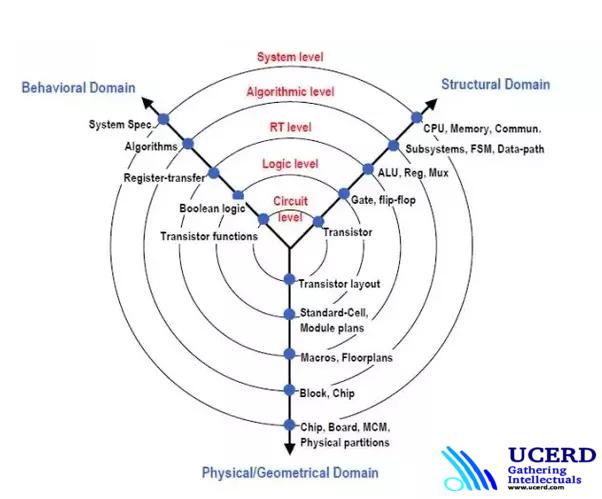Classification of ICs
Design Flow (Y-Map)
Fabrication Process
VLSI Components and Architectures
MOS Transistor Theory
Types of Integrated Circuits
MOS, NMOS, PMOS, CMOS
Combinational Logic Circuits
Multiplexer, Encoder, Decoder, State Machine, Orbiter and Scheduler
Tools: ROCCC, C2HDL LEGUP, Vivado, Quartus, Modelsim
Components: ALU, Buses, Registers etc.
Using processors, caches, buses etc.
Multi Processor System Design
Gallium arsenide, Graphene etc.
Ultra-Fast VLSI Circuits and System and their Design
3D Fabrication
Ultra-Fast VLSI Circuits and System and their Design
3D FPGA i.e Tabaula etc
Analog Circuit Design (Field Programmable Analog Arrays) FPAA
Complex Engineering Problem
Graphene transistors
VLSI tool for graphene transistors
VLSI Processor Design
(List of Opensource Processors)
VLSI System on Chip Design
Graphene transistors
VLSI tool for graphene transistors
VLSI Processor Design
(List of Opensource Processors)
VLSI System on Chip Design
Book: CMOS VLSI Design_ A Circuits and Systems Perspective (4th Edition 2010)
FPAA
GaAs
A Practical Approach to VLSI System on Chip (SoC) Design. A Comprehensive Guide
VLSI Physical Design: From Graph Partitioning to Timing Closure
FPAA
GaAs
A Practical Approach to VLSI System on Chip (SoC) Design. A Comprehensive Guide
VLSI Physical Design: From Graph Partitioning to Timing Closure
Video Tutorials:
Cadence Virtuoso Schematic, Layout Design and Simulations: Modularity, Grid System and DRC (Youtube)
Digital Simulations (Youtube)
Cadence Virtuoso Schematic, Layout Design and Simulations: Modularity, Grid System and DRC (Youtube)
Digital Simulations (Youtube)
Dr. Tassadaq Hussain:
He is a permanent faculty member at, Riphah International University.
He did his Ph.D. from Barcelona-tech Spain, in collaboration with Barcelona Supercomputing Center and Microsoft Research Center.
He is a member of HiPEAC: European Network on High Performance and Embedded Architecture and Compilation, Barcelona Supercomputing Center and Microsoft ResearchCentre Spain.
Until January 2018, he had more than 14 years of industrial experience including, Barcelona Supercomputing Centre Spain, Infineon technology France, Microsoft Research Cambridge, PLDA Italia, IBM Zurich Switzerland, and REPSOL Spain. He has published more than 50 international publications and filed 5 patents.
Tassadaq's main research lines are Machine Learning, Parallel Programming, Heterogeneous Multi-core Architectures, Single board Computers, Embedded Computer Vision, Runtime Resource Aware Architectures, Software Defined Radio and Supercomputing for Artificial Intelligence and Scientific Computing.
www.tassadaq.ucerd.com
He is a permanent faculty member at, Riphah International University.
He did his Ph.D. from Barcelona-tech Spain, in collaboration with Barcelona Supercomputing Center and Microsoft Research Center.
He is a member of HiPEAC: European Network on High Performance and Embedded Architecture and Compilation, Barcelona Supercomputing Center and Microsoft ResearchCentre Spain.
Until January 2018, he had more than 14 years of industrial experience including, Barcelona Supercomputing Centre Spain, Infineon technology France, Microsoft Research Cambridge, PLDA Italia, IBM Zurich Switzerland, and REPSOL Spain. He has published more than 50 international publications and filed 5 patents.
Tassadaq's main research lines are Machine Learning, Parallel Programming, Heterogeneous Multi-core Architectures, Single board Computers, Embedded Computer Vision, Runtime Resource Aware Architectures, Software Defined Radio and Supercomputing for Artificial Intelligence and Scientific Computing.
www.tassadaq.ucerd.com

Very Large Scale integration (VLSI) Design
UCERD Rawalpindi
Supercomputing Center
UCERD Murree
VLSI Design course emphasizes on imparting overall exposure to the concept and design methodologies of all significant aspects of VLSI engineering relevant to the industry needs. The program offers in-depth, hands-on training on various design methods such as gate level, register transfer level, abstract level designs, etc. At the end of the course, the student can understand the VLSI manufacturing processor, solve a real-world problems and map and port these issues in an integrated circuit.
At the end of my course, students should learn:
To identify the Physical Layout and Gate Level System Design using 65 nm ASIC technology.
To discuss a scalar RISC core and Application-Specific Hardware Accelerators.
To design and program Uni-core System on Chip (SoC) and Multi-core (SoC) architectures. Bus System Performance (data rate), Processor Performance (FLOPS), Memory Read Write Time.
To use an FPGA logic block for gate and switch level systems.
To develop a layout of semi custom ASIC logic cell of three input lookup table (LUT), an FPGA Configurable Logic Block (CLB by using VLSI Digital Schematic Editor & Simulator.
At the end of my course, students should learn:
To identify the Physical Layout and Gate Level System Design using 65 nm ASIC technology.
To discuss a scalar RISC core and Application-Specific Hardware Accelerators.
To design and program Uni-core System on Chip (SoC) and Multi-core (SoC) architectures. Bus System Performance (data rate), Processor Performance (FLOPS), Memory Read Write Time.
To use an FPGA logic block for gate and switch level systems.
To develop a layout of semi custom ASIC logic cell of three input lookup table (LUT), an FPGA Configurable Logic Block (CLB by using VLSI Digital Schematic Editor & Simulator.





